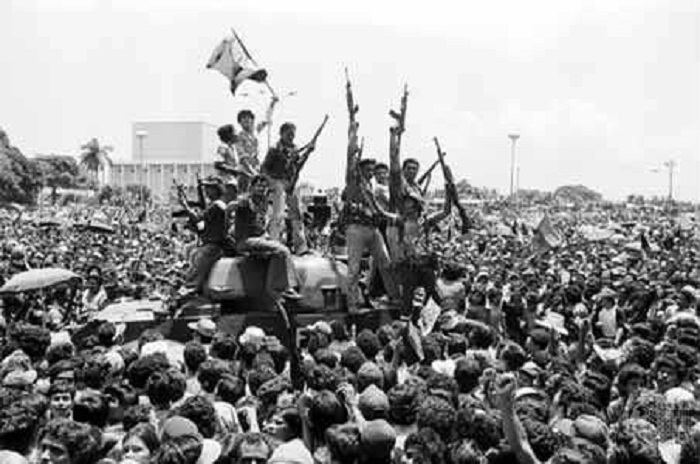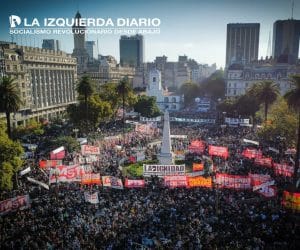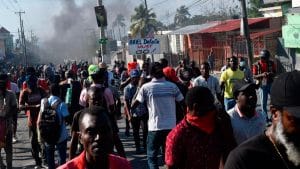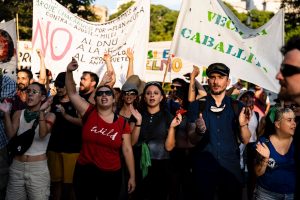The revolution in Nicaragua occurred in the context of a revolutionary situation in a region shaken by constant political and social upheavals during the mid-1970s and 1980s. After the U.S. defeat in Vietnam, a revolutionary upheaval took place in Central America that lent new momentum to struggles of workers, agricultural proletarians, the urban poor and poor peasants.
At the end of that decade, the revolution in Nicaragua achieved an important victory with the destruction of the National Guard and the defeat of the country’s dictator, Anastasio Somoza, through a combination of mass insurrection and guerrilla actions. What happened in Nicaragua and how can we understand the uprising and the aftermath?
The Context
The history of Nicaragua has been plagued by U.S. military interventions, defining the country’s politics throughout its history. The Somoza family’s iron grip on the country was practically created by U.S. imperialism. There was a strong U.S. military presence from 1911 to 1933, and it was those troops who built the genocidal National Guard and put at its head Anastasio Somoza García. After a 1936 military coup that was ratified by fraudulent elections, Somoza became the country’s president.
Before the rise of the Somoza dynasty, the government was run by Adolfo Díaz—a leader installed by the U.S. Marines. He was an American puppet and former secretary of a U.S. mining company. From 1927 to 1933, Augusto César Sandino led the struggle against U.S. imperialism and the Díaz government.
The war shook not only Diaz’s government but also the already-weakened state structure as a whole. With the massive support of the peasantry, Sandino’s war prevented the consolidation of the state, accelerated the crisis, and forced Washington to resort to a large-scale military intervention against Nicaragua in order to save what remained of the semi-destroyed state apparatus. The entire responsibility for the war, the public administration and the functions of the government passed into the hands of the invading army.
Imperialism’s main objective was to reconstitute a viable nation-state. To do so, it was necessary to completely destroy Sandino’s army, massacre the peasants who supported him, and assassinate Sandino himself, who by then was known as the General of Free Men. So the U.S. government rebuilt the state apparatus in Nicaragua by setting up the National Guard, and propping up Somoza in the service of the U.S. empire.
Somoza and his family owned most of the country. Colombian writer Laura Restrepo outlines how Somoza, in coalition with other families, managed 364 monopolies, which included banks as well as air, sea, and land transportation companies. They controlled the production of textiles, cigarettes, fertilizers, oils, cobblestones, nails, ice, copper, citrus, prefabricated houses, cement, and other products and resources. They did this with the help of U.S. companies, for which Somoza served as a partner, intermediary, and lieutenant.
The Somoza family remained in power for 45 years.
By the 1960s, however, a differentiation began to develop in the ranks of the bourgeoisie. There was a division between the oligarchy allied with the Somoza dynasty and the bourgeoisie who benefited from economic expansion—centrally the agro-exporting, agro-industrial, industrial, and banking sectors, for which the Somoza government became an impediment. These latter sections began to adopt an increasingly oppositional stance toward the Somoza government. Their opposition grew when, after an earthquake triggered a crisis in 1972, Somoza began displacing them from the economic activities they had traditionally controlled.
Under the impact and influence of the Cuban revolution, the Sandinista National Liberation Front (FSLN) was founded in 1961 by Tomás Borge, Carlos Fonseca Amador and Silvio Mayorga. It was a petty-bourgeois nationalist organization that launched a guerrilla war against the Somoza regime using this tactic as its main political strategy.
In the mid-1970s, after the murder of two of its founders, the FSLN organized into three distinct tendencies, each one with its own leadership: the Terceristas, whose leadership was mainly made up of Daniel Ortega, Víctor Tirado, and Humberto Ortega; the Prolonged People’s War (GPP), led mainly by Henry Ruiz and Tomás Borge; and the Proletarian Tendency, whose main leader was Jaime Wheelock. Of the three, the last one was considered the most left-wing, but the programmatic and political differences between the three were not significant enough to lead to major confrontations. For part of the 1970s, they acted separately but tacitly agreed to use the acronym FSLN. They were unified on March 7, 1979, in response to pressure from Fidel Castro, who offered them support if they merged.
In this context, the revolution in Nicaragua had the goal of resolving several structural issues. First, the revolution sought to achieve national liberation from imperialism, which had shaped nearly every aspect of Nicaraguan history. Second, it sought a resolution to the land question. Somoza’s family alone owned more than 22,000 square kilometers of arable land, and other large tracts of land were concentrated in very few hands. At the same time, millions of peasants lived in the most extreme poverty. Third, the revolution had to confront the dictatorial Somoza regime, which had in a sense fused with the state itself.
The Nicaraguan revolution needed to fulfill those structural, democratic tasks, but in order to achieve its goals, it had to go beyond those tasks. The capitalists, even the liberal ones opposed to the Somoza dictatorship, were unwilling to break with imperialism and expropriate the Somoza family as they profited too much from this relationship. This was a task that would have to be taken up by the working class.
The agrarian question, as well as the struggle against imperialism, gave the peasants—the majority of the Nicaraguan population—an important role in solving these democratic tasks. In this context, it was necessary to establish a revolutionary alliance between the working class and the peasants under the political leadership of a revolutionary party of workers. This alliance would only be possible through tireless fights against the influence of the liberal bourgeoisie, including those opposed to the Somoza dictatorship.
In this sense, once in power as the leader of the democratic revolution against imperialism and for land reform, the proletariat would find itself faced with the need to transform bourgeois property rights—that is, the need to expropriate the bourgeoisie—and to transform the democratic revolution directly into a socialist one. It is from this perspective and the strategy of permanent revolution that we analyze the revolution in Nicaragua.
The Nicaraguan Revolution Starts Brewing
During the 1970s, a great upheaval of the mass movement was reflected in the major strikes of 1973 and 1974, which were fiercely repressed. In 1975 and 1976, the government’s repression became increasingly bloody; it assassinated a founder of the FSLN, Carlos Fonseca Amador. Popular discontent grew from September 1977 onward.
In January 1978, the journalist Pedro Joaquín Chamorro was assassinated. This turned the situation around, leading the bourgeoisie who opposed Somoza to challenge the government more directly. But as the mass movement took action, this opposition bourgeoisie sought to conciliate and compromise with the dictatorship.
On August 12 of that same year, in the most spectacular action of the FSLN, the FSLN took over the National Palace of Nicaragua with the chambers of deputies and senators in session. At this point, the mass movement itself was in full swing, with large workers’ strikes in hospitals and other areas, including the private sector. The urban working class was in motion.
In September of that same year, the FSLN, launched a military offensive in several cities around the country. It believed it had sufficient forces to begin an attack on the dictatorship, although this action, in retrospect seems a bit adventurist. The action failed to achieve its objectives because the FSLN lacked coordination. It had to retreat without being able to consolidate itself in any city or establish a “liberated area,” which was part of its objectives.
The National Guard’s counterattack was brutal. The cities of Masaya, León, Chinandega, Jinotepe, Diriamba, and Estelí experienced shootouts and massacres, with an estimated 10,000 workers, youth, students and peasants killed. But this sinister attack did not break the will of a people who redoubled their efforts in the revolutionary struggle. The movement galvanized the working class and peasant masses, and thousands of young people joined the ranks of the FSLN.
The Insurrection of the Masses and the Fall of Somoza
General strikes, land occupations, and urban uprisings announced the masses’ entry into the political scene against the Somoza regime in the first months of 1979. The rise of the masses precipitated the decomposition of the regime and shattered the margins for maneuvering that the native bourgeoisie and imperialism needed to find a way out of this crisis.
On June 4, the mass organizations and the FSLN declared a general strike that paralyzed the whole country. In the days that followed, insurrections broke out in several cities across Nicaragua. But what turned the situation around was the spontaneous insurrectional movement in the neighborhoods of Managua on June 10. “Liberated zones” emerged in the capital. Nicaragua revolted, an unprecedented revolutionary crisis opened up, and Somoza’s fall was imminent.
U.S. imperialism, confronting the fact that the situation was getting out of hand, turned to the OAS to disguise a direct intervention. The U.S. proposed sending “peace forces,” a measure that received no international support. Somoza became increasingly isolated and was only backed by Latin American dictatorships. The U.S. expected Somoza to crack down hard on the workers and peasants, crushing the revolt. Then, imperialism could play a role in helping to erect a new bourgeois regime.
The governments of Venezuela, Mexico, Costa Rica and Panama lent themselves to this dirty work, doing what was in their power to prevent the civil war from breaking institutional continuity. In June, the formation of a Junta of National Reconstruction of Nicaragua (GRNN) took control of the state in the face of the imminent fall of Somoza. The GRNN was composed of two high representatives of the bourgeoisie: Violeta Chamorro, the widow of Pedro Joaquín Chamorro, and Alfonso Robelo Callejas; two representatives of the FSLN, Daniel Ortega and Moisés Hernán; and finally, one representative of the center and the professional sectors, Sergio Ramírez Mercado. This Junta was recognized by the Latin American governments mentioned above. By merging with the guerrilla forces of the FSLN, they planned to make sure that the National Guard had a space in the new government.
In the course of the insurrection, popular militias spontaneously emerged in order to fight against the National Guard. The spontaneous insurrections, the fierce resistance of the population and the attacks by the FSLN made the National Guard retreat and largely limit itself to strict defense of its barracks and to the defense of Somoza’s bunker.” Finally, Somoza left the government. He fled on July 17, opening the final phase of the regime’s overthrow.
Thanks to mass actions, the FSLN emerged victorious over the exhausted repressive forces of the regime. Faced with this, the United States was forced to accept the fall of Somoza. After Somoza’s escape, according to a previous agreement, Francisco Urcuyo- Somoza’s Vice President- had to transfer power to the “Junta de Gobierno”: a government made up of the FSLN and bourgeoisie in opposition to Somoza . But Urcuyo called on the masses to lay down their arms and at the same time affirmed that he would stay in power until the 1981 elections.
There was a mass revolt in response. The workers, the youth and the militias of the popular districts invaded Somoza’s bunker, distributed the tens of thousands of weapons of war that they recovered, and rose up in fierce combat. The National Guard broke into pieces and was defeated. On July 19, the FSLN forces entered the capital and installed the Government Junta.
The Results
The toll of the confrontations in this first period of the revolution included more than 40,000 dead and 100,000 wounded; this happened during a period when the central engine of production was made up of urban workers, the agricultural proletariat, poor people, semi-proletarians of the countryside, and poor peasants. As FSLN leader Humberto Ortega recognized, “It was the guerrilla that supported the masses,” and not the other way around.
Throughout this process, the workers actively participated in the insurrectionary struggle. The Nicaraguan working class, although not very numerous relative to the total population, played a prominent role in this revolution even though they did not advance to form their own organs of power—nor did any organization exist before, during, or after that could guide them in this direction. Nonetheless, workers constituted an element of the embryonic organizations of the masses, and they advanced as a class by establishing factory committees that voted for the expropriation of the company in multiple places.
According to accounts from the period, in places like Managua, managerial positions were voted on by working class assemblies.The formation of the union and the factory committee was approved, with delegates by sectors of labor; aboard of directors was voted, and the records were taken to the Attorney General’s Office, so that it could issue the respective Confiscation Decree and recognize the appointments made by the workers.
Throughout the previous three years, the Nicaraguan working class carried out general strikes, dozens of partial strikes, and ultimately an insurrectionary strike that included hundreds of armed workers in the neighborhoods and in the countryside, many of them as FSLN fighters. After the triumph of the revolution, some Trotskyist sectors oriented themselves exclusively toward the constitution of independent unions, an issue that the FSLN leadership did not tolerate, as it attempted to organize everything under its own structures and political leadership.
It is important to highlight the participation of the Trotskyists in this process. The Trotskyists organized the Simón Bolívar Internationalist Brigade to fight for the revolution. This group was promoted by the Socialist Workers’ Party (PST) of Colombia, an organization led by the Argentine Trotskyist Nahuel Moreno. Made up of about 110 combatants from different countries but mainly from Colombia, it entered Nicaragua in early June. Three heroic fighters were killed. Because they sought to organize independent unions, those who were not Nicaraguans were expelled from the country by the FSLN, handed over to the Panamanian police at the border and subsequently tortured and deported back to their countries.
The Junta of National Reconstruction: The FSLN and the Opposition Bourgeoisie
The great paradox of this revolution is that the representatives of capital were present in the government Junta, in the ministries, in the administrative apparatus of the state, and in the Central Bank.
The Council of State was composed of 30 members “directly represented and appointed by the following organizations and socio-economic groupings in the country”:
- The FSLN,
- Groups from the National Patriotic Front: United People’s Movement, Independent Liberal Party, Group of Twelve, Social Christian People’s Party, Nicaraguan Workers’ Central (CTN), Workers’ Front, Union of Radio Journalists,
- Groups from the Opposition Broad Front (FAO): Democratic Conservative Party, Nicaraguan Christian Social Party, Nicaraguan Democratic Movement, Constitutionalist Liberal Movement, Nicaraguan Socialist Party, General Confederation of Independent Labor, Confederation of Trade Union Unification (CUS),
- And groups from the Higher Council of Private Enterprise (COSEP): Nicaraguan Development Institute (INDE), Nicaraguan Chamber of Industries (CADIN), Nicaraguan Chamber of Commerce, Nicaraguan Union of Agricultural Producers (UPANIC), Nicaraguan Chamber of Construction.
During this process, virtually the entire Somoza sector was expropriated, the banking, insurance system and mining systems were nationalized, and stronger control was established over the financial sector and exports. Furthermore, there were massive literacy campaigns, universal public health systems, the recognition of land occupations and decrees of expropriation of idle or uncultivated land. Yet the entire bourgeois sector that was part of the new government or part of the opposition to Somoza was kept intact.
Meanwhile, the new government made significant concessions to the industrialists so as to receive international credit and integrate the anti-Somoza bourgeoisie into the task of “national reconstruction.” Economic development continued to be dominated by private property, and the state proposed the project of a mixed economy. Then began the disarmament of the population and the strengthening of an army, the Sandinista People’s Army (EPS).
Despite all this, the sector of the bourgeoisie present in the Junta resigned, but another sector was integrated. Representatives of this new sector of the bourgeoisie included Rafael Córdoba, leader of the Democratic Comillnservative Party and member of the Supreme Court of Justice, and Arturo Cruz, former collaborator of the Inter-American Development Bank. The FSLN increasingly took control of the government but without changing its strategic orientation toward class collaboration.
But one of the blows to the Nicaraguan revolution came from Cuba and the politics of Fidel Castro. Castro asserted that Nicaragua will not become another Cuba:
There are many questions now. There are many people who want to establish similarities between what occurred in Cuba and what has occurred in Nicaragua. … For this reason, to the assertions or fears expressed by some people … to the effect that Nicaragua would become another Cuba, the Nicaraguans have given them a magnificent reply: No. Nicaragua is going to become a new Nicaragua [prolonged applause], which is something quite different.
Castro said that the bourgeoisie should not be expropriated and that the revolution should not spread. This had the disastrous consequence of keeping Nicaragua isolated and slowing down new Central American revolutionary processes.
Military Counterinsurgency and Counterrevolutionary “Peace”
For imperialism, the importance of Central America is not only economic but fundamentally geopolitical, especially in the context of the Cold War and the USSR’s regional role established through Castroism. That is why the United States was determined to crush the revolution in Nicaragua, which, if extended, could have spread to the whole of Central America, as was already happening in El Salvador.
For this reason, after President Reagan’s election, the imperialist counteroffensive began, organizing the “contra” (counterrevolutionary) mercenary armies. The revolution was permanently besieged with military actions and bombardments of key sectors of the economy, such as the Pacific harbors. While making concessions to the bourgeoisie, the Sandinista government demanded sacrifices from the masses in the tasks of defense and reconstruction of the country. The masses responded to the war efforts, but the bourgeoisie boycotted the economy.
The Reagan administration had launched an openly interventionist policy of counterrevolution. It organized the Contra gangs (veteran mercenaries) in Nicaragua and militarily strengthened the genocidal armies of Central America. To this end, it transformed Honduras into a landing strip for U.S. aircraft carriers, as the local headquarters of the Contras, the CIA, and the Pentagon. It waged one of the most complex and bloody counterinsurgency wars in the history of Latin America.
Nicaragua was ravaged by a brutal economic crisis. The destruction caused by the revolution was worsened by the brazen actions of the Contras, such as the destruction of infrastructure and the bombardments in places like Puerto Corinto. Hyperinflation of 30,000 percent a year wreaked havoc on the workers’ economy. Instead of taking deep measures against the bourgeoisie, such as the general expropriation of the landowners and other anti-imperialist measures, the Sandinista leadership made more and more concessions. The Contras took advantage of the discontent of the poor peasants and used it to form a social base.
Even so, because of the difficulties in defeating the revolution militarily, imperialism began to combine the militarist offensive with the policy of negotiation and “peace” agreements. Thus, in 1983, the Contadora Group was created, made up of the governments of Colombia, Mexico, Panama and Venezuela. Their objective was to reach “peace” agreements to dismantle the revolutionary processes of Central America. Thus, a division of tasks took place: The Contras and the genocidal armies attacked with weapons and the Contadora group went on the offensive with diplomatic papers.
In 1987, the Esquipulas II agreements were signed by several Central American Presidents. They said that to “achieve peace,” the Central American states continued to “request [that] regional or extraregional governments that support anti-government armed movements cease that support; they call for a cease-fire and commit themselves to prevent the use of their territories for destabilizing actions against other governments.” This agreement was not signed by Panama, the location of one of U.S.’s most important military bases in the Western Hemisphere.
The Sandinista government submitted to all these negotiations and placed the Contras and the bourgeoisie on an equal footing with the thousands of fighters, workers, and poor peasants fighting for their national liberation in El Salvador through the Farabundo Martí National Liberation Front (FMLN). While preventing any action by the Salvadoran fighters on its territory, the government made more agreements with sectors of the Contras, as well as with the counterrevolutionary bourgeoisie itself. The Esquipulas II agreements seemed to be forgotten in the transition between Presidents Reagan and George Bush Sr., but in February 1989, Ortega resumed negotiations on the occasion of the meeting of the five Central American presidents in the Salvadoran town of Costa del Sol.
By not fulfilling the fundamental demands that the Nicaraguan revolution had called for, such as the agrarian revolution, the expropriation of the bourgeoisie, and national liberation, the Sandinista government lost ground in the midst of a crisis provoked by the U.S. war of economic harassment and sabotage and by the Contras.
The Nicaraguan government decided to move the elections to February 1990 and to accept the proposed modifications to the 1988. It accepted a general election plan in which those who financed and organized the counterrevolution could participate normally. In February 1990, the Sandinistas suffered a heavy defeat by the bourgeois parties with Violeta Chamorro heading a mega-electoral coalition that even included the Communist Party of Nicaragua. This defeat accelerated the negotiation process, which would lead to the signing of the “peace accords” in El Salvador and Guatemala. While this complex process is beyond the scope of this article, it is important to note that the main objective behind the negotiations was the dismantling Central American revolutions.
The Role of Leadership in the Region as a Whole
U.S. imperialism was central in shaping the results of the revolution in Nicaragua. Although it did not engage in classic intervention, it organized and financed a major counterrevolutionary war that forced an already weakened country to use significant material and human resources to confront it. Although it had the existing military base in Panama, the United States built a new one in Honduras as a way of destroying the revolution. From there, the offensive against Nicaragua was set in motion; from there, important economic structures such as the aforementioned Puerto Corinto were bombarded. Then came the policy of counterrevolutionary “peace.”
It is also important, however, to understand the role played by Stalinism and Castroism in this context, as well as that of the region’s petty-bourgeois nationalist leaderships.
Stalinism and Castroism made the most strenuous efforts to first limit and then contain the Central American revolution. They attempted to confine each step within the framework of national states imposed by U.S. imperialism. The disarmament of the fighters and the electoral processes were agreed upon by the negotiation committees in which the leadership of the FSLN participated, the leadership of the Salvadoran guerrilla army under the sponsorship of Castro and Soviet diplomacy, and the bourgeois governments of Latin America and the United States.
The result is clear: Even after years of heroic combat, during which almost 300,000 fighters died, imperialist “order” prevails in Central America. The extension and triumph of the Central American revolution—and its unity in a federation with Cuba—would have been one of the most terrible blows to U.S. imperialism.
First published in Spanish on July 21 in Ideas de Izquierda.
Translation: Óscar Fernández










